Related Research Articles

Provincetown Harbor is a large natural harbor located in the town of Provincetown, Massachusetts. The harbor is mostly 30 to 90 feet deep and stretches roughly 1 mile (1.6 km) from northwest to southeast and 2 miles (3.2 km) from northeast to southwest – one large, deep basin with no dredged channel necessary for boats to enter and exit.

The Gold Lifesaving Medal and Silver Lifesaving Medal are U.S. decorations issued by the United States Coast Guard. The awards were established by Act of Congress, 20 June 1874; later authorized by 14 U.S.C. § 500. These decorations are two of the oldest medals in the United States and were originally established at the Department of Treasury as Lifesaving Medals First and Second Class. The Department of the Treasury initially gave the award, but today the United States Coast Guard awards it through the Department of Homeland Security. They are not classified as military decorations, and may be awarded to any person.

The United States Life-Saving Service was a United States government agency that grew out of private and local humanitarian efforts to save the lives of shipwrecked mariners and passengers. It began in 1848 and ultimately merged with the Revenue Cutter Service to form the United States Coast Guard in 1915.

The Virginia Beach Surf & Rescue Museum honors and preserves the history of Virginia's maritime heritage, coastal communities, the United States Lifesaving Service, and the United States Coast Guard along the Atlantic coast.
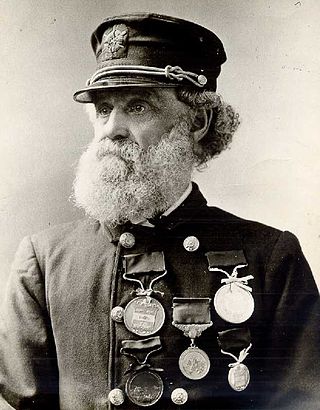
Joshua James was an American sea captain and a U.S. Life–Saving Station keeper. He was a famous and celebrated commander of civilian life-saving crews in the 19th century, credited with saving over 500 lives from the age of about 15 when he first associated himself with the Massachusetts Humane Society until his death at the age of 75 while on duty with the United States Life–Saving Service. During his lifetime he was honored with the highest medals of the Humane Society and the United States. His father, mother, brothers, wife, and son were also lifesavers in their own right.
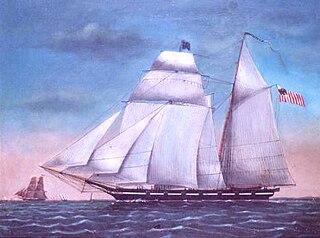
The United States Revenue Cutter Hamilton was one of 13 cutters of the Morris-Taney Class to be launched. Named after Secretaries of the Treasury and Presidents of the United States, these cutters were the backbone of the Service for more than a decade. Samuel Humphreys designed these cutters for roles as diverse as fighting pirates, privateers, combating smugglers and operating with naval forces. He designed the vessels on a naval schooner concept. They had Baltimore Clipper lines. The vessels built by Webb and Allen, designed by Isaac Webb, resembled Humphreys' but had one less port.

Pea Island Life-Saving Station was a life-saving station on Pea Island, on the Outer Banks of North Carolina. It was the first life-saving station in the country to have an all-black crew, and it was the first in the nation to have a black man, Richard Etheridge, as commanding officer. On August 3, 2012, the second of the Coast Guard's 154-foot Sentinel-Class Cutters, USCGC Richard Etheridge (WPC-1102), was commissioned in his honor.
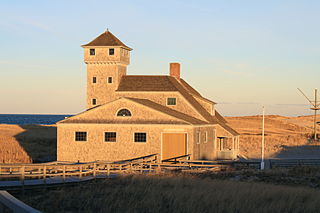
The Old Harbor U.S. Life Saving Station is a historic maritime rescue station and museum, located at Race Point Beach in Provincetown, Massachusetts. Built in 1897, it was originally located at Nauset Beach near the entrance to Chatham Harbor in Chatham, Massachusetts. It was used by the United States Life-Saving Service (USLSS), and then by its successor, the United States Coast Guard (USCG), as the Old Harbor Coast Guard Station. The station was decommissioned in 1944, abandoned and sold as surplus in 1947, and was used as a private residence for the next twenty-six years.

United States Coast Guard Station Manomet Point was a United States Life-Saving Service station – and later a United States Coast Guard station – located on Manomet Point in Manomet, Massachusetts. The station was a sub-unit of Sector Southeast New England.

The Humboldt Bay Life-Saving Station was originally built in November 1878 on the north side of the entrance to Humboldt Bay in northern California, United States near Eureka, adjacent to the site of the first Humboldt Harbor Light (1856–1892). Rebuilt in 1936 with marine railways to launch rescue surfboats, the historic facility was placed on the National Register of Historic Places on October 30, 1979. The station continues to function as an important asset of the United States Coast Guard in the Coast Guard Group/Air Station Humboldt Bay.
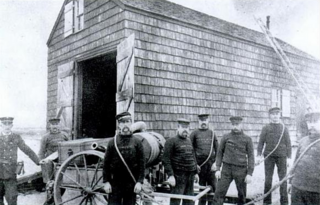
Coast Guard Station Toms River is a former United States Coast Guard station in Seaside Park, New Jersey, at the mouth of the Toms River. The area was manned in 1856 with Samuel Chadwick as the first lifeguard. The first boathouse was constructed in 1872 by the New Jersey Life Saving Service as the Toms River Life Saving Station. Station Toms River was United States Life-Saving Service Station #13 and Coast Guard's Station #109 in the 5th District.
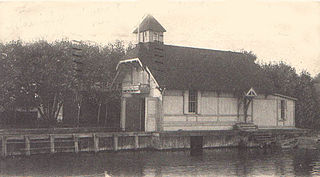
Joseph Napier, a station keeper for the United States Life-Saving Service founded the lifesaving station at St. Joseph, Michigan in 1876. He operated the station for many years and was credited with many dangerous and heroic rescues.

Liana's Ransom is a pirate-themed party vessel, operated from Nova Scotia.
USCGC Cape Horn was a 95-foot (29 m) type "C" Cape-class cutter constructed at the Coast Guard Yard at Curtis Bay, Maryland, in 1958 for use as a law enforcement and search and rescue patrol boat.
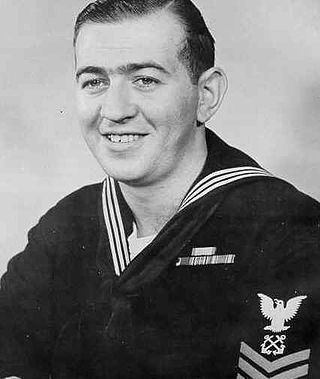
Bernard Challen Webber was a United States Coast Guardsman. He was a petty officer assigned to Coast Guard Station Chatham, Massachusetts, where one of his duties was that of coxswain of Coast Guard Motor Lifeboat CG 36500. Webber and his crew of three rescued the crew of the stricken T2 tanker SS Pendleton, which had broken in half during a storm on February 18, 1952 off Cape Cod. Webber maneuvered the 36-foot lifeboat under Pendleton's stern as the tanker's crew, trapped in the stern section, abandoned the wreck of their ship on a Jacob's ladder into the Coast Guard motor lifeboat.

USCGC Isaac Mayo is a Sentinel-class cutter homeported in Key West, Florida. She is the twelfth Sentinel class to be delivered, and the sixth of six to be assigned to Key West.

Winslow W. Griesser (1856–1931) was a station keeper in the United States Life-Saving Service, one of the agencies that were merged to form the United States Coast Guard. In 2016 the Coast Guard honored him by naming one of its new Sentinel-class cutters, USCGC Winslow W. Griesser, after him.

Bailey Taylor Barco was a stationkeeper and Captain with the United States Life-Saving Service—one of the agencies later merged into the United States Coast Guard. He led a rescue at his station Dam Neck Mills in present-day Virginia Beach, on December 21, 1900.

USCGC Benjamin Dailey (WPC-1123) was the United States Coast Guard's 23rd Sentinel-class cutter. She was the first cutter of her class stationed in the Coast Guard's Eight District, with a homeport in Pascagoula, Mississippi.
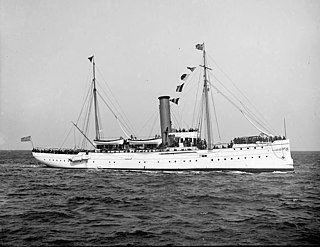
USRC Gresham was a cruising cutter and auxiliary gunboat built for the United States Revenue Cutter Service to patrol the Great Lakes. She was one of a series of cutters named for former U.S. Secretaries of the Treasury. Her namesake Walter Q. Gresham served as the 35th Secretary of the Treasury in 1884 and died in 1895 while serving as the 33rd U.S. Secretary of State. She became part of the newly created United States Coast Guard in 1915, and also served as a coastal convoy escort and patrol boat under United States Navy control during both World War I and World War II. After being decommissioned by the Coast Guard in 1944, she eventually came under Israeli control in 1947. She carried Jewish refugees from Italy to Palestine and later served in the fledgling Israeli Navy until 1951.
References
- 1 2 3 4 Stephanie Young (2010-11-10). "Coast Guard Heroes: Isaac Mayo". United States Coast Guard . Retrieved 2012-04-26.
- ↑ Annual report of the operations of the United States Life–Saving Service. United States Life-saving Service. 1879. pp. 49–42, 54, 72. Retrieved 2012-08-26.
- ↑ "US Coast Guard Awards: Isaac F. Mayo". United States Coast Guard. 1879-11-10. Retrieved 2012-08-26.
In recognition of the services he rendered in this rescue, Captain Mayo received the Gold Lifesaving Medal.
- ↑ Mary L. Landrieu (2012-03-05). "Tribute To Coast Guard Heroes". Capitol Words. Archived from the original on 2014-09-03. Retrieved 2013-01-10.
Others, such as Isaac Mayo and Joseph Napier, returned to shore multiple times to reembark on new boats after previous attempts caused them to capsize and several of their fellow crewmen to perish in the punishing waves. Both men eventually completed their rescue missions successfully.
- ↑ Percy Cushing (1912-08-03). "Wrecks of the Massachusetts Coast". The Appeal. p. 1. Retrieved 2013-01-12.
- ↑ "Pursuing the Whale" . Retrieved 2013-01-12.
What has made the sailors of Cape Cod and the islands of Nantucket and Martha's Vineyard world-renowned as the best men that ever trod the deck of a vessel? Qne of the great reasons is that from boyhood they are accustomed to being in boats and to seeing deeds of valor and heroism performed that have gone with them through life. Among the many such scenes that I witnessed when a young man, one stands out that made the greatest impression upon me: the rescue by Captain Isaac F. Mayo and a volunteer crew of the crew of the Sarah J. Fort, ashore at Peaked Hill Bars off Cape Cod.
- ↑ The Boston Almanac and Business Directory, Volume 45. Sampson, Davenport. 1879. p. 39 . Retrieved 2013-01-12.
The heroic conduct of Capt. Isaac F. Mayo, of Provincetown, and his boat's crew, who rescued the survivors on the wreck of the schooner Sarah J. Fort, at Peaked Hill Bars, Cape Cod, April 4, has been acknowledged by the presentation of a silver medal to each man by the Humane Society of Massachusetts.
- ↑ Humane Society of the Commonwealth of Massachusetts (1880). Charter and by-laws of the Humane Society of the Commonwealth of Massachusetts: instituted in 1786. With a selected list of premiums awarded from June, 1876, to June 1880, and a list of the officers and trustees. Also a list of lifeboats and mortar stations with other data. Press of T. R. Marvin & son . Retrieved 2013-01-12.
To Captain Isaac F. Mayo, Murdock Kemp, Benjamin W. Atkins, Kenneth McPhee and Allen McLeod, for their successful efforts in saving the crew of the schooner Sarah J. Fort, on the 3d of April, the Silver Medal. And, in addition, a Diploma was presented to Captain Isaac F. Mayo, of Provincetown, in recognition of the great energy, efficiency, and courage shown by him in organizing and leading a boat's crew to the schooner on the same occasion.
- ↑ Bob Lind (2016-02-25). "Coast Guard cutter named after ND farmer who was also East Coast seaman" . Retrieved 2016-02-27.
In March 2015, a Coast Guard cutter named Isaac Mayo was commissioned in Key West, Fla. It was named for a man who had two widely different jobs in two widely different areas: He was a seaman on the Atlantic Ocean and a farmer in North Dakota.
- ↑ "FRC Plan B: The Sentinel Class". Defense Industry Daily. 2014-05-02. Archived from the original on 2014-07-07. Retrieved 2014-04-03.
All of these boats will be named after enlisted Coast Guard heroes, who distinguished themselves in USCG or military service. The first 25 have been named, but only 8 have been commissioned...
- ↑ Stephanie Young (2010-10-27). "Coast Guard Heroes". United States Coast Guard. Archived from the original on 2012-11-27. Retrieved 2012-04-20.
- ↑ "Acquisition Update: Coast Guard Commissions 12th Fast Response Cutter". United States Coast Guard. 2015-03-30. Archived from the original on 2015-04-03. Retrieved 2016-02-27.
The Coast Guard commissioned Isaac Mayo, the 12th fast response cutter and sixth to be based in Key West, Florida, March 28, 2015.